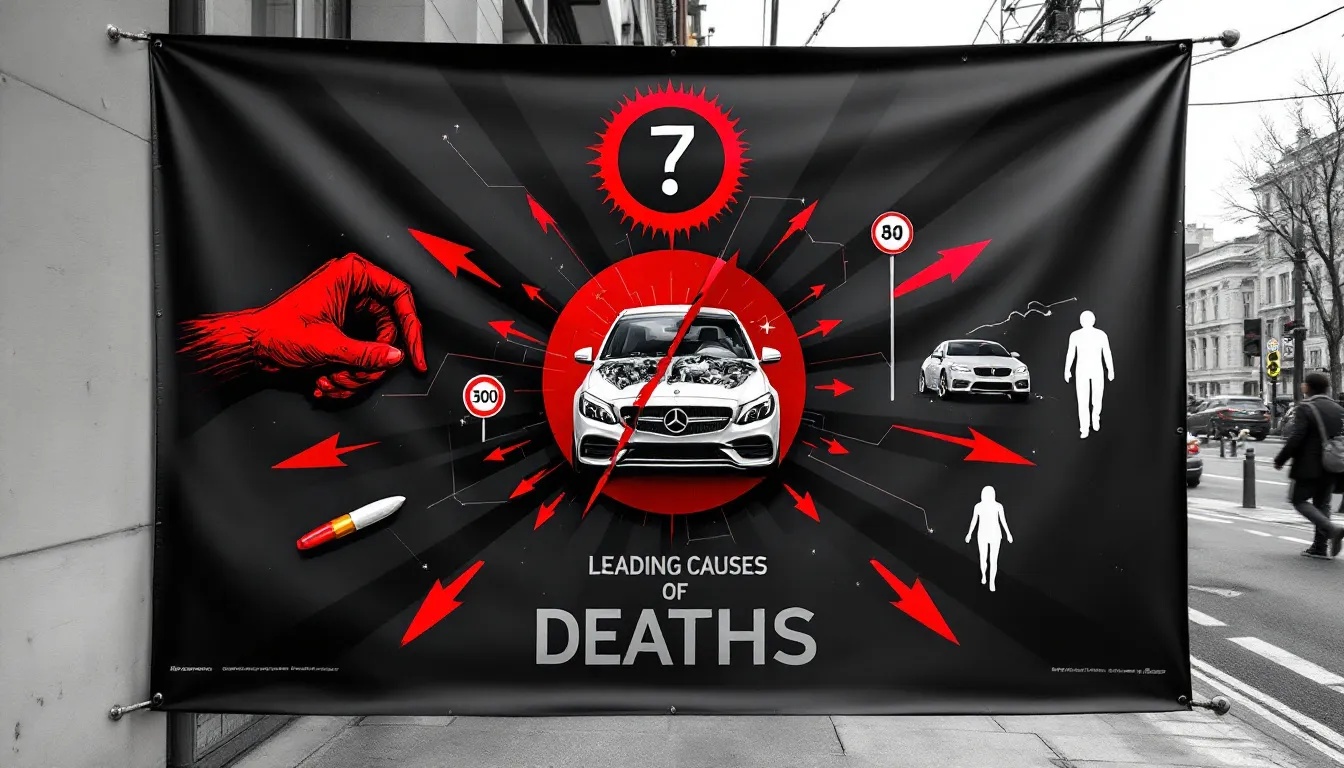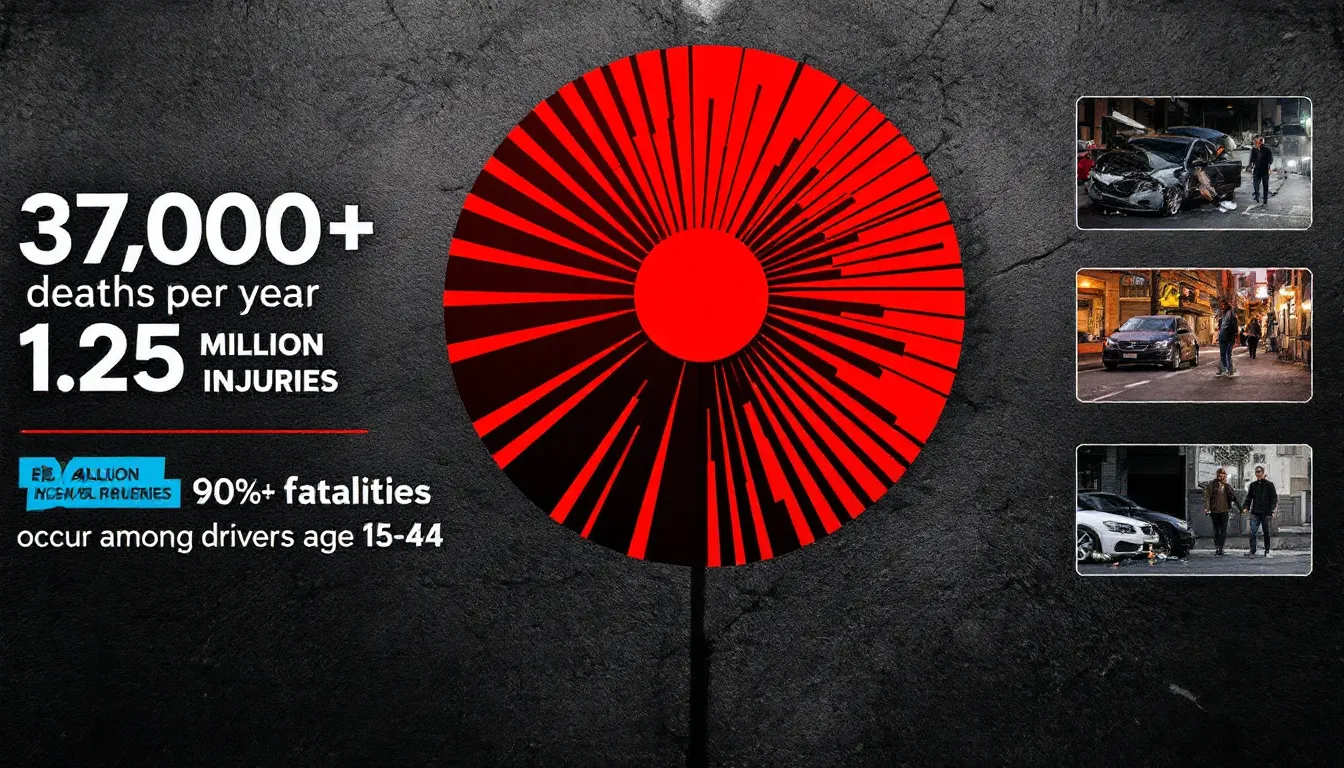How Many Automobile Deaths in US: Latest Statistics and Insights
In 2023, about 40,999 people died in traffic crashes in the US, raising the question of how many automobile deaths in the US occur each year. This article explores the latest statistics, leading causes, and preventive measures to understand and tackle this critical issue.
If you or someone you know has been involved in an accident, contact 1-800-THE-LAW2 for a free legal consultation with an attorney in our network.
Key Takeaways
- In 2023, the US saw a slight decrease in automobile deaths to 40,999, indicating a positive trend for road safety, though fatalities remain a critical concern.
- Distracted driving and alcohol impairment are the leading causes of motor vehicle fatalities, emphasizing the need for targeted awareness campaigns and stricter enforcement of driving laws.
- Young and male drivers are at notably higher risk for fatal accidents, highlighting the necessity for demographic-specific safety interventions to reduce fatalities.
Current Automobile Death Statistics in the US
The dynamics of traffic-related fatalities in the United States have undergone significant changes recently. In 2023, motor vehicle crashes led to approximately 40,999 deaths—a minor decrease from the previous year’s count of 40,990 fatalities—representing a dip of 3.6% in terms of million vehicle miles traveled. This decline brings a cautious sense of optimism within the context of persistent traffic-related deaths yet starkly contrasts with a substantial increase of 10.5% in motor vehicle fatalities from 2020 to 2021, emphasizing both the inconsistency and critical nature surrounding this issue.
During the first quarter of 2024, there was an estimated total death toll from roadway incidents recorded at roughly 8,650 people. This showcases a drop when compared to figures during that same period in early last year which showed there were about close to 9k (or precisely put – eight-thousand-nine-hundred-thirty-five) mortalities reported back then hence reflecting what seems like continual albeit gradual progress being made. However, having had on average monthly fatality rates throughout last year set at three thousand-eight hundred and thirty-six victims projects how serious road collisions continue to be as they tragically end lives too soon—with concerns pressing regarding mortality rates situated per every 100,000 people.
Highlighting such numbers highlights just how vital it is for ongoing work aimed towards betterment and improving overall driving safety thus reducing common risk factors associated with those aforementioned devastating losses happening due to automobile accidents can be kept minimal going forward into future times ahead.
Leading Causes of Automobile Deaths

Grasping the predominant factors behind motor vehicle deaths is vital for formulating strategies to prevent them. Two major culprits contributing to motor vehicle crashes that lead to death are driving while distracted and operating vehicles under the influence of alcohol. These behaviors pose a significant threat not just to those inside the car, but also have extensive repercussions on overall public safety.
To better understand their effects, it’s important to examine in greater detail how each of these issues influences deaths resulting from motor vehicle accidents.
Distracted Driving
Mobile phone use while driving is a prime factor in motor vehicle crashes, notably contributing to driver distraction. The demographic of drivers between 18 and 34 years old stands out as being the most at risk for deadly incidents caused by such distractions. It’s not just a brief diversion. Mobile phone usage when behind the wheel can result in dire outcomes. Distracted driving accounts for approximately 8% of all traffic fatalities, which corresponds to more than 3,000 deaths each year.
The mortality rate among young motorists, particularly those within the 20-24 age bracket, is alarmingly high compared with older demographics. These figures underscore an immediate need to implement focused educational initiatives and enforce existing laws regarding distracted driving more rigorously. A concentrated effort on these fronts may significantly diminish fatalities that are otherwise avoidable due to common on-road diversions.
Alcohol Impairment
The issue of alcohol-related impairment persists, accounting for approximately 28% of all deadly vehicular accidents. Despite extensive campaigns to raise awareness, a considerable number of motorists still misjudge how much their driving abilities are hindered after drinking alcohol. This often leads to them taking unnecessary risks on the road since alcohol tends to decrease one’s risk perception and can escalate the likelihood of partaking in dangerous driving practices.
A particularly alarming aspect is that numerous drivers labor under the delusion that they are capable of safely operating a vehicle even when their blood alcohol content (BAC) is high. Such mistaken confidence may result not only in catastrophic outcomes for the intoxicated driver but also pose significant dangers to others using the same thoroughfares.
To mitigate fatalities tied to alcohol consumption, it’s imperative that we confront these dangerous misunderstandings with improved educational strategies and rigorous enforcement of laws against driving under the influence (DUI).
Automobile Deaths by Demographics

Analyzing automobile deaths by demographics provides valuable insights into which groups are most at risk and why. Age and gender play significant roles in determining the likelihood of being involved in fatal motor vehicle crashes.
By understanding these patterns, we can better tailor our safety measures to protect the most vulnerable populations and reduce the death rate.
Age Group Analysis
Drivers within the 16-24 age bracket are more prone to involvement in fatal motor vehicle crashes. This demographic represented around 20% of traffic-related fatalities in 2022. The lack of driving experience coupled with propensities for risky behavior among teenagers plays a considerable role in these figures. In that year, teenage drivers were involved in car accidents leading to 2,898 deaths, which constituted about 7% of all deaths due to motor vehicle crash incidents.
In contrast, older drivers encounter elevated risks too, but for different reasons compared to their younger counterparts. For male drivers specifically, there is a sharp increase in the fatality rate as they age, especially hitting its peak within those over eighty years old. These statistics highlight the distinct need for safety initiatives tailored separately to both young and senior motorists given their divergent risk factors.
Comprehending how these risks vary with age is imperative when formulating strategies aimed at curbing death rates from road mishaps amongst all groups by age classification, as highlighted by the Centers for Disease Control and Prevention (CDC).
Gender Differences
There is a pronounced gender disparity in deaths resulting from motor vehicle accidents, with males accounting for approximately 70% of all casualties. This discrepancy prevails throughout diverse age brackets. Specifically, males between the ages of 16 and 19 experience a mortality rate of 14.7 per hundred thousand individuals — strikingly surpassing that observed among females within the same age range. During the year 2022, the death rates for male occupants in passenger vehicles were twice as high compared to those recorded for female occupants across various age groups, thus significantly impacting overall statistics on motor vehicle crash deaths.
It is crucial to recognize this persistent pattern and initiate safety initiatives tailored toward decreasing mortality rates amongst male drivers. By identifying and comprehending factors such as propensities toward riskier behavior or distinct driving habits that contribute to these gender-based disparities in fatalities, more effective methods can be devised to enhance vehicular safety universally.
State-by-State Comparison
An examination of death rates from automobile accidents across various states uncovers considerable disparities in motor vehicle crash deaths on a regional basis. Analyzing which states experience the most and least fatalities can assist in pinpointing successful safety strategies as well as regions that require more attention.
We will delve into the states that have recorded the maximum and minimum numbers of deaths resulting from motor vehicle crashes.
Highest Fatality States
Texas holds the grim title for the most motor vehicle crash deaths, with a total of 4,068 fatal events recorded in 2023. California is not far behind, with reported fatalities amounting to 3,983 from car accidents and securing its position as second on this unfortunate list. Completing the top trio is Florida with a count of 3,451 deadly automobile incidents that same year.
The alarmingly high numbers of roadway fatalities emphasize an urgent need for strategic safety initiatives and campaigns aimed at increasing public awareness within these regions. Contributors to such dire statistics include aspects like how densely populated an area is, variations in road infrastructure quality, and local driving practices unique to each state.
A thorough analysis of these contributing elements can pave the way towards designing effective strategies specific to areas where they’re needed most so as to mitigate mortality rates due to traffic collisions.
Lowest Fatality States
Rhode Island recorded the smallest number of deadly car crashes, reporting a mere 61 occurrences in the year 2023. Meanwhile, the District of Columbia registered an even lesser number of fatal car collisions within the same timeframe. These jurisdictions stand out as exemplars of efficient roadway safety protocols and motorist conduct.
The markedly reduced incidence of fatalities in these areas is likely due to several influences such as rigorous enforcement of traffic regulations, impactful public safety initiatives, and superior emergency response services. Examining the effective approaches taken by these states could provide valuable insights for other areas looking to enhance their own road safety statistics.
Impact of Safety Measures
Safety measures have played a pivotal role in reducing automobile fatalities over the years. From seat belts to advanced vehicle technologies, these interventions have saved countless lives.
Let’s explore the impact of some of the most effective safety measures.
Seat Belt Use
In 2023, it was recorded that a significant majority of 91.9% of individuals complied with the use of seat belts, serving as an essential method to diminish deaths associated with motor vehicles. Notwithstanding this high adherence rate, data from 2022 disclosed that only 45% of restrained fatally injured occupants were wearing their seat belts at the time. This substantial gap underlines how crucial adhering to seat belt laws is in preserving lives.
Outcomes from the previous year demonstrated that non-use of seat belts accounted for approximately half of all fatally injured passenger vehicle occupants. Historical data indicates that around 375,000 lives have been safeguarded by these devices over time—proving their indispensable contribution to automotive protection strategies. Thus, prioritizing unwavering promotion and utilization of seat belts remains instrumental in reducing death rates among those fatally injured while restrained and mitigating injuries among occupants within passenger vehicles.
Technological Advancements
Advances in technology have been pivotal in decreasing the number of deadly vehicle accidents. Breakthroughs like collision detection and automatic braking systems have improved vehicle safety dramatically, averting numerous potential crashes and protecting injured passenger vehicle drivers. Since becoming compulsory for new cars in 2011, electronic stability control has played a key role by assisting drivers to keep their vehicles under control during difficult driving conditions.
Airbags serve as another essential element of car safety, credited with saving over 50,000 lives since they became commonly incorporated into vehicles starting in the late 1980s. The integration of airbags with other contemporary protective technologies such as stability control has greatly reduced the chances of death resulting from car collisions.
The evolution of these technologies underscores the continuing significance that advancements play in elevating standards for vehicular security.
Economic and Emotional Consequences
The repercussions of fatalities from vehicle accidents extend significantly, both economically and emotionally. In 2022, the financial impact of traffic collisions was estimated at approximately $340 billion, which equates to nearly 3% of the nation’s gross domestic product (GDP). This substantial cost encompasses medical bills, lost workforce productivity, and damages to property—imposing a heavy fiscal weight on society.
The psychological aftermath for those who survive car crashes is overwhelming as well as widespread. Survivors often grapple with anxiety or post-traumatic stress disorder (PTSD), with occurrence rates varying between 19% and an alarming 60%, significantly affecting injured passenger vehicle occupants. The ensuing reduction in their quality of life can result in enduring emotional strife and diminish their ability to function normally over time.
Henceforth, addressing these far-reaching economic burdens along with providing support for survivors’ emotional health becomes imperative in aiding individuals touched by vehicular incidents—and thereby bolstering community resilience as a whole.
Legal Aspects and Insurance Implications
The process of dealing with the legal and insurance ramifications following deaths caused by car accidents is complex. Drivers in the majority of states must maintain at least a basic level of liability insurance to drive legally. Such coverage plays a crucial role in addressing damage inflicted on others during an accident, securing financial safeguarding for all individuals concerned.
When lodging an insurance claim following a vehicular incident, comprehensive documentation is essential, which includes obtaining a police report and capturing images of the crash site. Insurance firms conduct exhaustive probes into these claims, scrutinizing statements from witnesses and assessing traffic regulations to assign fault appropriately.
Enlisting legal assistance can streamline this complex procedure, helping ensure that those affected are justly compensated for their losses.
Preventive Measures and Recommendations
To mitigate the incidence of fatalities on the road, it is crucial to adopt a holistic strategy that encompasses both prudent driving habits and the integration of new technologies. The tendency for drivers to misjudge their level of impairment following alcohol consumption often results in dangerous behavior while operating a vehicle. Embracing responsible driving practices such as restricting travel during night-time hours and limiting passenger numbers can play an important role in decreasing fatal accident rates.
Opting for vehicles with exemplary safety ratings and employing cutting-edge safety features are additional steps toward bolstering occupant protection should collisions occur. Specialized training aimed at enhancing driver capability under adverse weather conditions can instill greater confidence and competence behind the wheel, thereby contributing to fewer traffic accidents. Through these comprehensive preventative tactics, we stand to improve overall roadway security for all users. If you find yourself involved in an accident, contact an attorney in our network by calling 1-800-THE-LAW2.
Summary
To effectively tackle the complex issue of automobile deaths in America, a thorough and all-encompassing strategy is necessary. Recent data indicates a minor drop in fatalities, yet the figures are still disturbingly high. The prevalence of distracted driving and alcohol impairment plays a significant role as leading contributors to these tragedies, calling for precise intervention strategies alongside more rigid enforcement of existing safety regulations. Demographic analysis Reveals that younger drivers and males are disproportionately affected, which points to the importance of designing prevention measures specifically catered to those groups.
A closer look at fatality rates across individual states highlights noticeable differences attributed to various regional factors. Implementation of safety protocols such as seat belt usage and embracing technological innovations have been instrumental in curtailing death tolls. Their effectiveness hinges on uniform adherence nationwide. Beyond the immediate loss of life lies an extensive socioeconomic impact brought about by automobile deaths—extending its reach from victims’ family circles out into broader community networks—as well as introducing layers related to legal intricacies alongside insurance issues demanding comprehensive understanding and foresightful planning. Advancing preventive tactics combined with cultivating an ethos centered around conscientious driving practices stands imperative if we aspire to substantial progress toward diminishing incidences of auto-related mortalities while bolstering overall traffic security. If you or someone you know has recently been involved in a car accident, contact 1-800-THE-LAW2 for a free legal consultation with an attorney from our network.
Frequently Asked Questions
What are the main causes of automobile deaths in the US?
The main causes of automobile deaths in the US are distracted driving, especially from mobile phone use, and alcohol impairment. These factors play a crucial role in the high rates of fatal accidents on the roads.
How do automobile death rates vary by age and gender?
Automobile death rates significantly vary by age and gender, with young drivers aged 16-24 and males being at the highest risk. Males account for approximately 70% of motor vehicle fatalities, consistently surpassing female death rates.
Which states have the highest and lowest automobile death rates?
Texas, California, and Florida have the highest automobile death rates, while Rhode Island and the District of Columbia report the lowest rates. This disparity underscores the importance of implementing specific safety initiatives in areas with higher fatalities.
What impact have safety measures had on reducing automobile deaths?
Safety measures, including seat belt use and advancements like airbags and electronic stability control, have greatly decreased automobile fatalities. The implementation of these technologies enhances protection and actively prevents accidents.
What are the economic and emotional consequences of automobile deaths?
Automobile deaths result in significant economic losses, estimated at around $340 billion, while the emotional consequences for survivors and families include anxiety, PTSD, and long-term psychological distress, profoundly affecting their quality of life.




